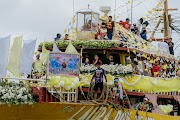The density of heritage homes found within the limits of what may be considered its poblacion, or city-center, is perhaps unmatched. The National Historical Commission of the Philippines counts over 30. This makes Silay in Negros Occidental visibly extraordinary. Here, no single street can claim monopoly of these head-turning vestiges of a glorious past, colonial homes are practically everywhere. And there is logic to this. 
Discover the many conversation pieces and turn-of-the-century lifestyle imports strewn in every corner of the Pink House.
Friars who came in and out of Negros since the 1500s left indelible footprints along this coastal community, so much so that by the mid-1700s Silay held prominent space in the minds and hearts of both the Spanish government and the church. Any development, therefore, had Silay in mind. Still, the affluence that built Silay’s colonial homes came from sugar, and the rich soil of Silay welcomed the early haciendas (sugarcane plantations) and the mansions of their owner hacenderos. 
Tony Montinola, grandson of Bernardino and Ysabel Jalandoni, currently manages the Pink House with his wife, Chona.
With nearby towns still to be established, money twirled happily within Silay, at each turn contributing to the rise of a sometimes-genteel, sometimes-lavish lifestyle framed within the iron gates of her colonial homes. In addition to architecture, wealth funded a taste for the arts and intellectual discussion in both politics and trade stayed sophisticated. Higher education was highly desired, and with money to spare, children were sent to boarding schools in Manila and abroad. 
Balay Puti, the ancestral home of Emilio and Rosario Ledesma, reopens after the pandemic as a restaurant and events venue.
In their day, colonial homes were simply homes. And though present times may picture them as excess, historical revisionism is unforgivable. Claro M. Recto once said, “Nationalism is nourished by a sense of history. It is of its essence to know profoundly the past, so that we may be in complete openness with the men who made that history and in intimate communion with their thoughts, their deeds, and their noble lives.” Indeed, the builders of the colonial homes of Silay charted the growth of Negros Occidental. 
A palatial staircase and brilliant design details like the sugarcane decals on glass doors greet you at the Balay Puti foyer.
In this National Heritage Month of May, Negros Season of Culture trains its lights on this part of Negrense history and heritage, the beauty of Silay’s colonial homes and the sense of history that they impart.
There is something special about old homes located around or in proximity to the public plaza. These are often looked upon with extra deference. Long before there were gated communities, these “Calle Real” (royal street) homes were prime residential addresses. A hundred years back, they had the first paved streets and the first street lamps. 
A road widening project in the 70s could have disfigured the rose-toned facade of the Don Bernardino Jalandoni House in Silay. But concerned citizens protested.
One such address in Silay is the colonial home of Bernardino and Ysabel Jalandoni. Built in 1908, and popularly known as the “Pink House”, today it stands as a museum. The preservation of its exterior architecture reflects the upkeep of its interiors. Original furniture pieces and furnishings offer students of design stunning period specimens. The embossed tin tiles on the ceiling have to be unique to the property.
A palatial staircase and brilliant design details like the sugarcane decals on glass doors greet you at the Balay Puti foyer.
A great example of a repurposed colonial property in Silay is the ancestral home of Emilio and Rosario Ledesma built in 1919. It was home to their daughter Adela until 2012. An extensive reconstruction project followed during the pandemic lockdown period, carefully restoring the grandeur of the structure’s exteriors. Reborn to a new name, Balay Puti, today it is home to a fine dining establishment, Stephen’s at Balay Puti, run by Chef Stephen Escalante.
Chef Stephen Escalante runs the fine dining restaurant at Balay Puti.
Balay Puti is an experience to behold. Its Old World charm lures people through its storied halls and into a culinary experience made possible by a refurbished kitchen set up. The property’s renaissance is truly a remarkable way of preserving heritage for future generations.
Story By: Alan S. Gensoli
Photos By: Unit A Creatives
Design and Architecture
Cultural Experience
Art and Craft
Food
People
BAO
-

Negros Season of Culture

Rooted. Taking on the World.
A global messaging system that promotes the cultural assets of Negros as shaped by its rich heritage and traditions, the unique identity of the place, and the talent of its people.
Popular Posts
Linutik
Friday, August 27, 2021

Chicken Ubad with Monggo (Chicken with Banana Pith and Mung Beans)
Thursday, July 15, 2021

Dinagsa Festival
Sunday, January 07, 2024
Rooted. Taking on the World.
Negros Season of Culture is a global messaging system that promotes the cultural assets of Negros as shaped by its rich heritage and traditions, the unique identity of the place, and the talent of its people.
Search This Site
Quick Links
People
Design and Architecture
Upcoming Events
Art and Craft
BAO
Food
Menu Footer Widget
Rooted. Taking on the World.
A global messaging system that promotes the cultural assets of Negros as shaped by its rich heritage and traditions, the unique identity of the place, and the talent of its people.
Search This Site
Upcoming Events
 Negros Season of Culture Celebrates National Heritage Month
Negros Season of Culture Celebrates National Heritage Month
The Negros Season of Culture Celebrates National Heritage Month this... Negros Season of Culture joins the National Commission on Culture and the Arts in celebrating National Heritage Month
Negros Season of Culture joins the National Commission on Culture and the Arts in celebrating National Heritage Month
Negros Season of Culture joins the National Commission on Culture...
Menu Footer Widget
• Copyright © -2021
- Negros Season of Culture



